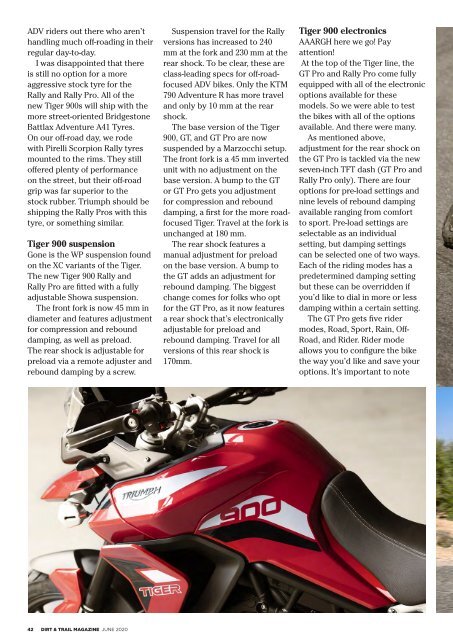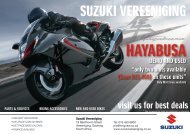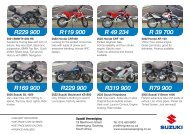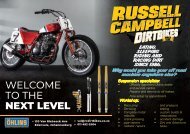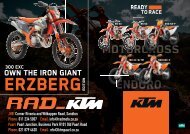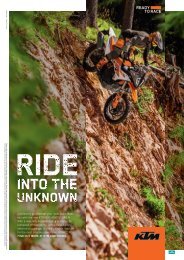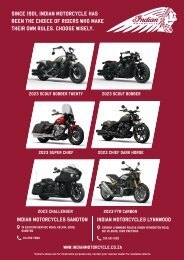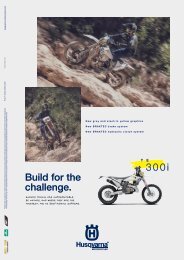Dirt and Trail June 2020-2
You also want an ePaper? Increase the reach of your titles
YUMPU automatically turns print PDFs into web optimized ePapers that Google loves.
ADV riders out there who aren’t<br />
h<strong>and</strong>ling much off-roading in their<br />
regular day-to-day.<br />
I was disappointed that there<br />
is still no option for a more<br />
aggressive stock tyre for the<br />
Rally <strong>and</strong> Rally Pro. All of the<br />
new Tiger 900s will ship with the<br />
more street-oriented Bridgestone<br />
Battlax Adventure A41 Tyres.<br />
On our off-road day, we rode<br />
with Pirelli Scorpion Rally tyres<br />
mounted to the rims. They still<br />
offered plenty of performance<br />
on the street, but their off-road<br />
grip was far superior to the<br />
stock rubber. Triumph should be<br />
shipping the Rally Pros with this<br />
tyre, or something similar.<br />
Tiger 900 suspension<br />
Gone is the WP suspension found<br />
on the XC variants of the Tiger.<br />
The new Tiger 900 Rally <strong>and</strong><br />
Rally Pro are fitted with a fully<br />
adjustable Showa suspension.<br />
The front fork is now 45 mm in<br />
diameter <strong>and</strong> features adjustment<br />
for compression <strong>and</strong> rebound<br />
damping, as well as preload.<br />
The rear shock is adjustable for<br />
preload via a remote adjuster <strong>and</strong><br />
rebound damping by a screw.<br />
Suspension travel for the Rally<br />
versions has increased to 240<br />
mm at the fork <strong>and</strong> 230 mm at the<br />
rear shock. To be clear, these are<br />
class-leading specs for off-roadfocused<br />
ADV bikes. Only the KTM<br />
790 Adventure R has more travel<br />
<strong>and</strong> only by 10 mm at the rear<br />
shock.<br />
The base version of the Tiger<br />
900, GT, <strong>and</strong> GT Pro are now<br />
suspended by a Marzocchi setup.<br />
The front fork is a 45 mm inverted<br />
unit with no adjustment on the<br />
base version. A bump to the GT<br />
or GT Pro gets you adjustment<br />
for compression <strong>and</strong> rebound<br />
damping, a first for the more roadfocused<br />
Tiger. Travel at the fork is<br />
unchanged at 180 mm.<br />
The rear shock features a<br />
manual adjustment for preload<br />
on the base version. A bump to<br />
the GT adds an adjustment for<br />
rebound damping. The biggest<br />
change comes for folks who opt<br />
for the GT Pro, as it now features<br />
a rear shock that’s electronically<br />
adjustable for preload <strong>and</strong><br />
rebound damping. Travel for all<br />
versions of this rear shock is<br />
170mm.<br />
Tiger 900 electronics<br />
AAARGH here we go! Pay<br />
attention!<br />
At the top of the Tiger line, the<br />
GT Pro <strong>and</strong> Rally Pro come fully<br />
equipped with all of the electronic<br />
options available for these<br />
models. So we were able to test<br />
the bikes with all of the options<br />
available. And there were many.<br />
As mentioned above,<br />
adjustment for the rear shock on<br />
the GT Pro is tackled via the new<br />
seven-inch TFT dash (GT Pro <strong>and</strong><br />
Rally Pro only). There are four<br />
options for pre-load settings <strong>and</strong><br />
nine levels of rebound damping<br />
available ranging from comfort<br />
to sport. Pre-load settings are<br />
selectable as an individual<br />
setting, but damping settings<br />
can be selected one of two ways.<br />
Each of the riding modes has a<br />
predetermined damping setting<br />
but these can be overridden if<br />
you’d like to dial in more or less<br />
damping within a certain setting.<br />
The GT Pro gets five rider<br />
modes, Road, Sport, Rain, Off-<br />
Road, <strong>and</strong> Rider. Rider mode<br />
allows you to configure the bike<br />
the way you’d like <strong>and</strong> save your<br />
options. It’s important to note<br />
“Power comes on much sooner<br />
<strong>and</strong> stronger. The low- to midrange<br />
grunt is immediately<br />
noticeable. And the sound <strong>and</strong><br />
feel are impressive.”<br />
that ABS cannot be turned off via this control<br />
setup. That option is reserved for a sixth riding<br />
mode, Off-Road Pro, which is only available on<br />
the Rally Pro.<br />
I think this is an oversight on Triumph’s<br />
part. I don’t think it makes sense to make this<br />
mode available only in the Rally Pro version of<br />
the bike. Riders who are perfectly happy with<br />
the GT Pro or the base Rally should be able to<br />
configure the settings how they see fit. They<br />
shouldn’t have to bump to the Rally Pro in<br />
order to fully disable ABS <strong>and</strong> traction control.<br />
More on this later.<br />
Each of the ride modes adjusts throttle<br />
response <strong>and</strong> intervention from the ABS,<br />
traction control, cornering ABS, <strong>and</strong> cornering<br />
traction control, the latter two being provided<br />
via a new Continental Inertial Measurement Unit<br />
(IMU). The base Tiger is the only one of the five<br />
models not to receive the IMU.<br />
The two top-of-the-line models also get<br />
heated grips, heated seats (rider <strong>and</strong> pillion), a<br />
tyre pressure monitoring system, <strong>and</strong> Triumph’s<br />
Shift Assist Pro, which allows for clutchless<br />
upshifts <strong>and</strong> downshifts. There is also a new<br />
version of the Triumph MyApp program for<br />
turn-by-turn directions available with these<br />
models. We got to try a BETA version of this<br />
but there proved to be quite a few connectivity<br />
issues. It’ll be interesting to see how that<br />
improves, because it worked really well when it<br />
was working.<br />
There are four different dash layouts<br />
available but my biggest gripe is that none of<br />
them provided a clear, easy-to-read tachometer<br />
layout. It was hard to see exactly where I was in<br />
the rev range.<br />
Navigating the dash was a bit cumbersome,<br />
as well. I have used previous versions of<br />
Triumph’s TFT dashes so I was able to figure<br />
out the layout relatively quickly. However,<br />
some of my colleagues who haven’t had the<br />
same previous level of exposure to Triumph<br />
products struggled to figure out exactly where<br />
to find certain features without a lot of back <strong>and</strong><br />
forth. More so than ever before, I’d recommend<br />
new Triumph Tiger 900 owners spend some<br />
considerable time with their owners manuals<br />
before heading out for a ride.<br />
Riding the Tiger 900 on the road<br />
We started out with a street ride that had us<br />
leaving Marrakesh early on Saturday morning<br />
<strong>and</strong> ending the day south of the coastal city of<br />
Essaouira. Throwing a leg over the Tiger 900,<br />
42 DIRT & TRAIL MAGAZINE JUNE <strong>2020</strong> DIRT & TRAIL MAGAZINE JUNE <strong>2020</strong> 43


